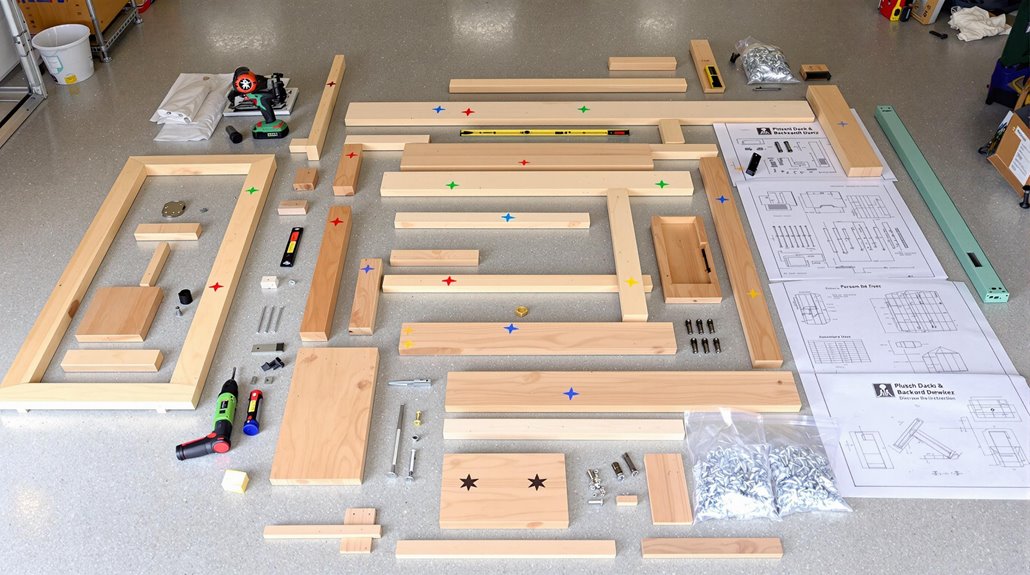I’m excited to share my experience building custom playsets that’ll bring endless joy to your backyard. As someone who’s constructed multiple DIY play structures, I’ve learned the critical balance between creative design and safety requirements. From selecting pressure-treated lumber to positioning the perfect swing height, every detail matters when crafting a durable outdoor playground. Let’s explore how you can transform basic materials into your children’s dream play space.
Essential Tools and Materials Checklist

Before starting your DIY playset project, I’ll help you gather the essential tools and materials needed to build a safe, sturdy structure for your backyard.
My tool selection strategies focus on ensuring you have reliable equipment, including a circular saw, power drill, post-hole digger, level, and measuring tape.
When it comes to material sourcing tips, I recommend purchasing pressure-treated lumber from reputable home improvement stores, along with galvanized hardware and rust-resistant screws.
You’ll need concrete for the post foundations, weather-resistant wood for the main structure, and durable swing components rated for children’s use.
I always suggest buying extra materials to account for potential mistakes or adjustments, especially with vital safety elements like handrails and structural supports.
Safety Considerations and Building Permits
Now that you’ve gathered your tools and materials, let’s address the safety requirements and building permits for your backyard playset project. I’ll help you navigate through the essential safety guidelines and permit requirements to guarantee your project meets all local regulations.
| Safety Requirement | Action Needed |
|---|---|
| Building Permit | Check with local authorities |
| Ground Safety | Install protective surfacing |
| Height Restrictions | Verify zoning limitations |
| Setback Rules | Measure property boundaries |
Before breaking ground, I recommend contacting your local building department to understand specific requirements for playground structures. You’ll need to take into account fall zones, which typically extend 6 feet beyond any climbing or swinging components. I always tell my readers that proper anchoring is non-negotiable – your playset must be secured at least 2 feet deep for maximum stability.
Popular Playset Design Options
While many standard playset designs exist on the market, I’ve found that the most successful backyard playsets combine multiple play elements that match your children’s interests and available space.
Popular swing set styles include classic A-frame designs with dual swings, tire swings, and trapeze bars, while modern climbing frame designs offer challenging elements like rock walls, cargo nets, and rope ladders.
I recommend considering a modular design that lets you add features as your children grow. You might start with a basic fort platform with a slide and swings, then expand to include monkey bars, climbing walls, or a clubhouse with a telescope.
Remember to choose designs that offer multiple entry and exit points, which helps prevent bottlenecks when several children are playing.
Step-by-Step Construction Guide

Building your own playset starts with a detailed construction plan that I’ve broken down into clear, manageable phases.
I’ll guide you through proper wood selection techniques, focusing on pressure-treated lumber for ground contact and weather-resistant hardwoods for the upper structure.
For safe assembly methods, I recommend starting with the main support posts, ensuring they’re set at least 2 feet deep in concrete.
Next, you’ll construct the platform frame, making sure to use galvanized hardware and carriage bolts at every major joint.
I’ve found that pre-drilling holes prevents wood splitting and makes the entire structure more stable.
When you’re ready to add features like slides and swings, I’ll show you the correct mounting techniques that’ll keep your children secure during play.
Weather Protection and Maintenance Tips
To keep your playset in top condition year after year, proper weather protection and regular maintenance are absolutely vital. I recommend applying weather resistant finishes to all wooden surfaces every 12-18 months, focusing on horizontal areas where water tends to pool.
I’ve found that seasonal maintenance is key for longevity. In spring, I’ll check for loose bolts and hardware, inspect for splintered wood, and examine chain connections.
During summer, I make sure to look for insect damage and clean any mold growth.
Fall’s the time when I’ll clear leaves from platforms and check roof sections.
In winter, I’ll remove snow accumulation from flat surfaces and guarantee proper drainage around the foundation.
If you spot any issues during these checks, address them immediately to prevent bigger problems.
Playset Enhancement Ideas and Accessories
Once you’ve built your basic playset, there’s a world of exciting accessories and enhancements that’ll transform it into an adventure playground.
I recommend starting with classic swing attachments, including belt swings, disc swings, and a cozy two-person glider that’ll encourage social interaction.
To boost physical development, I suggest adding challenging climbing features like cargo nets, rock walls, or monkey bars at appropriate heights for your children’s ages.
You can also install engaging accessories like telescopes, steering wheels, or speaking tubes that’ll spark imaginative play.
For comfort and safety, I always incorporate shaded areas with canvas covers and comfortable spots to rest, like a built-in bench or picnic table where parents can supervise while kids explore their enhanced play space.







